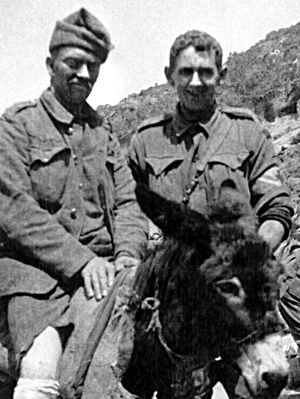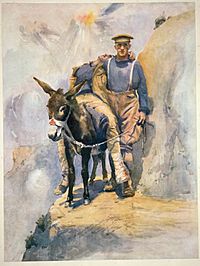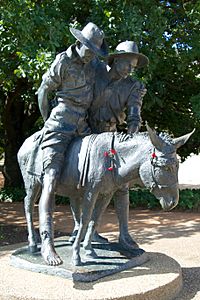John Simpson Kirkpatrick facts for kids
Quick facts for kids
John Simpson
|
|
|---|---|

Simpson (right) with his donkey
|
|
| Birth name | John Kirkpatrick |
| Born | 6 July 1892 South Shields, England |
| Died | 19 May 1915 (aged 22) Anzac Cove, Gallipoli, Ottoman Turkey |
| Buried |
Beach Cemetery, Gallipoli
|
| Branch | |
| Years of service | 1914–1915 |
| Rank | Private |
| Service number | 202 |
| Brigade | 3rd Field Ambulance |
| Battles/wars | First World War |
John Kirkpatrick (who joined the army as John Simpson; born 6 July 1892 – died 19 May 1915) was a stretcher bearer during the Gallipoli campaign. This was a major battle in the First World War, where Allied forces tried to capture Constantinople, the capital of the Ottoman Empire (old Turkey).
After the soldiers landed at Anzac Cove on 25 April 1915, Simpson started using donkeys to help wounded soldiers. He would give them first aid and then carry them to the beach. From there, the soldiers could be taken away for more help. He did this brave work for three and a half weeks, often while under enemy fire. Sadly, he was killed by machine-gun fire during a battle called the third attack on Anzac Cove. John Simpson and his donkey became a famous part of the Anzac legend, a story of bravery and mateship.
Contents
Early Life and Travels
John Simpson was born on 6 July 1892 in South Shields, England. His parents, Sarah and Robert Kirkpatrick, were from Scotland. He was one of eight children. When he was young, he worked with donkeys during his summer holidays. He went to Barnes Road Junior School and later Mortimer Road Senior School.
When he was 16, he joined a British Army reserve group called the Territorial Force. In early 1909, he started working in the British merchant navy.
In May 1910, Simpson left his ship without permission in Newcastle, Australia. He then traveled all over Australia, doing many different jobs. He worked cutting sugarcane in Queensland and mining coal in New South Wales. In the few years before World War I began, he worked on ships along the Australian coast. He was a steward, a stoker (who looked after the ship's engines), and an oiler.
Simpson had strong ideas about fairness for working people. He wrote to his mother, saying he hoped working people in England would "wake up" and change things. He believed a "good revolution" could help get rid of millionaires and lords. He thought a Labour Government would help workers make their own rules. Some people believe he was part of a radical workers' union called the Industrial Workers of the World, but this has never been officially proven.
A Hero in the War
After World War I started, Simpson joined the Australian Army. He probably did this to get back to England. He joined as "John Simpson" and may have used a different name to avoid trouble for leaving his ship earlier. On 23 August 1914, he joined as a field ambulance stretcher bearer in Perth, Australia. This job was only given to very strong men. He trained at Blackboy Hill Training Camp and was given the army number 202. He was part of the 3rd Australian Field Ambulance.
Helping Wounded Soldiers
On 25 April 1915, Simpson landed on the Gallipoli Peninsula with his unit. Early the next day, he was carrying a wounded friend on his shoulders when he saw a donkey. He quickly started using the donkey to help carry his injured fellow soldiers. Simpson would often sing and whistle, seeming to ignore the bullets flying around him, as he cared for his comrades.
He used at least five different donkeys during the Gallipoli campaign. Some of their names were "Duffy No. 1," "Duffy No. 2," "Murphy," "Queen Elizabeth," and "Abdul." Some of these donkeys were hurt or killed in the fighting. Simpson and his donkeys soon became a common sight to the Anzacs (Australian and New Zealand soldiers). Many soldiers knew Simpson by nicknames like "Scotty" (because of his Scottish family) and "Simmy." Simpson himself was sometimes called "Murphy." Other stretcher bearers started to copy Simpson and use donkeys too.
Colonel (who later became General) John Monash wrote about Simpson. He said that Simpson and his donkey were admired by everyone. They worked day and night since the landing, and their help to the wounded was very important. Monash wrote that Simpson was fearless. He moved calmly through exploding shells and rifle fire, doing his self-chosen job every day. He often earned praise for his brave rescues of wounded men from dangerous areas.
Other stories from the time also talk about Simpson's bravery. They mention his important work bringing wounded soldiers down from the hills above Anzac Cove. However, using a donkey made his job easier than other stretcher bearers. They had to carry seriously wounded men on stretchers from the front lines, which was much harder and more dangerous.
His Bravery and Death
On 19 May 1915, during the Third attack on Anzac Cove, John Simpson was killed by machine gun fire.
Private Victor Laidlaw, another medic, wrote in his diary about Simpson's death. He said that Simpson was a private in the 1st Field Ambulance. He had been working between the main camp and the front lines, bringing down wounded soldiers on a donkey. Laidlaw wrote that Simpson had done very important work. One day, as he was bringing a man down from the trenches, he was shot "right through the heart." Laidlaw said everyone was sad because this man was noticed by all. Everyone knew him because he always worked with his donkey, cheerful and willing. Laidlaw wrote that Simpson "goes to his death as a soldier."
John Simpson was survived by his mother and sister, who still lived in South Shields. He was buried at the Beach Cemetery in Gallipoli.
Remembering John Simpson
Who Was the Man with the Donkey?
Soon after he died, people started to mix up Simpson with other stretcher bearers who also used donkeys at Anzac Cove. One of these was Dick Henderson from the New Zealand Medical Corps. Henderson later said he took over one of Simpson's donkeys, named "Murphy."
A famous picture (on the right) of Dick Henderson with a donkey at Gallipoli has often been wrongly thought to be John Simpson Kirkpatrick. The picture came from a photograph taken by Sergeant James G. Jackson on 12 May 1915. This was a week before Simpson died. The picture became famous after Horace Millichamp Moore-Jones, a New Zealand artist, painted at least six versions of it. After Simpson's death, Henderson continued to rescue wounded soldiers and later received a bravery medal called the Military Medal.
Moore-Jones' paintings were usually called things like Private Simpson, D.C.M., & his donkey at Anzac or The Man with the Donkey. Many artworks and sculptures have been made based on this image. A version of it was even put on three postage stamps in Australia in 1965 to mark 50 years since Gallipoli.
The Legend Grows
The stories about Simpson, sometimes called "Murphy," grew a lot after his death. This was mainly because of a book published in 1916 called Glorious Deeds of Australasians in the Great War. This book was written to make people feel good about the war. Many of its stories about Simpson, like him rescuing 300 men or running into dangerous areas to carry wounded soldiers on his back, are not actually true. It would have been impossible to carry that many men to the beach in the three weeks he was at Gallipoli, given how long each trip took. However, many people believed the stories in the book, and some later books about Simpson also repeated them without checking.
Why No Victoria Cross?
Over the years, many people have asked for Simpson to be given a Victoria Cross (VC). The VC is the highest award for bravery. There is a common belief that he was recommended for a VC, but that the army either refused it or lost the paperwork. However, there is no official document that shows such a recommendation was ever made. The idea that he should get a VC comes from his commanding officer's diary entries. The officer hoped Simpson would receive either a Distinguished Conduct Medal or a VC. But this officer never made a formal recommendation for either medal. Simpson did receive a "Mention in Despatches," which means he was specially mentioned for his bravery. This was a common way to recognize other men who did similar brave work at Gallipoli.
In April 2011, the Australian Government announced that Simpson would be one of thirteen soldiers whose bravery would be looked at again. This was part of an inquiry into "Unresolved Recognition for Past Acts of Naval and Military Gallantry and Valour." The group looking into this was asked to suggest if any awards, including the Victoria Cross, should be given. In February 2013, the inquiry finished its work. It recommended that Simpson should not receive any further award. They decided that his "initiative and bravery were representative of all other stretcher-bearers... and that bravery was appropriately recognised... by the award of an MID" (Mention in Despatches).
Images for kids




